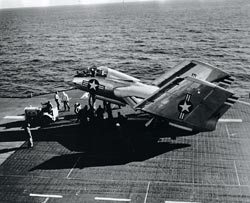|
|||||||
|
The F7U-3 was equipped with the AN/APG-30 radar, and the Aero A-10D fire control system with automatic gun sight. The engines contained automatic trim nozzles. The cockpit was pressurized, and the pilotís seat had emergency ejection capability. Inboard wing trailing edge speed brakes were provided for combat maneuvering and for landing use. The airplane was designed with both an in-flight refueling probe and with provisions for pylon mounted external fuel tanks. A fuselage fuel pod was also available for use in place of the removable rocket pack. Ability to carry the 5-inch HVAR and AR rockets and the 2.75-inch FFAR and 2.25-inch SCAR air-to-ground rockets on wing pylons was added.
Missile development in conjunction with flight testing in the development squadrons (VX4) led to the capability for carrying Sidewinder missiles on the basic F7U-3, and for the Sparrow missile in later versions (F7U-3M). The F7U-3 airplanes were phased off the carriers in late 1957 as they were replaced by new airplane models that were easier to maintain and operate.
|

 Production deliveries from Vought to the U.S. Navy were as follows: 10 in 1952, 82 in 1953, 68 in 1954, and 20 in 1955, for a total of 180 airplanes. Thirteen squadrons (10 fleet squadrons) received the F7U-3 between June 1954 and December 1956. The Cutlass flight performance was excellent with superior dogfight capability. The bomb-carrying capabilities led the U.S. Navy to change many of the squadron designations from VF to VA (attack ) squadrons. The Cutlass, however, experienced excessive downtime due to lack of reliability of systems equipment and nose gear problems which plagued operations.
Production deliveries from Vought to the U.S. Navy were as follows: 10 in 1952, 82 in 1953, 68 in 1954, and 20 in 1955, for a total of 180 airplanes. Thirteen squadrons (10 fleet squadrons) received the F7U-3 between June 1954 and December 1956. The Cutlass flight performance was excellent with superior dogfight capability. The bomb-carrying capabilities led the U.S. Navy to change many of the squadron designations from VF to VA (attack ) squadrons. The Cutlass, however, experienced excessive downtime due to lack of reliability of systems equipment and nose gear problems which plagued operations.